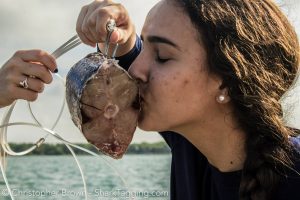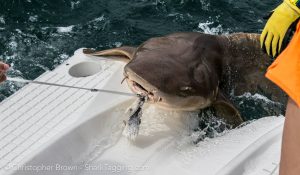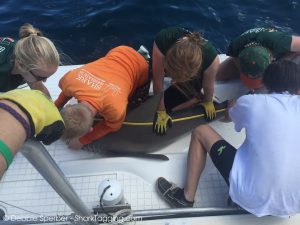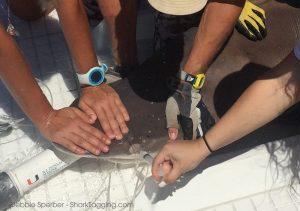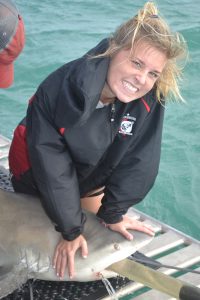Shark Tagging with an International French Highschool
By Julia Whidden, RJD Graduate Student
C’était un vendredi fantastique à bord le navire du Divers Paradise avec nos nouveau amis d’une école secondaire en la France! (Translation: It was a fantastic Friday on board the Divers Paradise boat with our friends from a high school in France!)
The RJD team met at Crandon Marina at 8 am to begin loading up at Divers Paradise, hopeful that the stormy weather forecast for the day was exaggerated. During our round of RJD and student introductions, we learned that only 3 of the 28 students had ever seen a shark before, yet they were all eager to learn as much as they could about shark biology!
We set out on the water towards Safety Valve under a grey sky. Nearly immediately, the sky opened and poured down on us – but luckily this weather didn’t last. As we approached our field site, we set two barracuda-baited fish traps near where our drum lines would be deployed to look at the fish communities in our sampling area. These traps were left there until the very end of the day. Next, we set the first 10 drumlines, which was followed by collecting environmental data like water temperature, salinity, and dissolved oxygen. In the hour of soak time required for the first set of lines, Dr. Neil Hammerschlag briefed our high school group about what to expect if we caught a shark, how they would be involved, and how our research impacts shark conservation and management. The high school students pulled the first 10 lines to find absolutely no sharks! We set the second set of drumlines, enjoyed a brief lunch, and then headed back to work. New RJD Interns Julia, Chris, and Dana had just finished talking about how they hadn’t yet seen a hammerhead shark when our first line of the second set came up with just that! The RJD team sprung into action as the students watched from the top deck. This female great hammerhead measured 2.18 m long (7’1” feet) and was processed off the back of the boat as opposed to being brought up onto the platform. Dr. Neil secured the hammerhead’s head, RJD Intern Chris inserted the water pump into the shark’s mouth, and Captain Eric held onto the tail as RJD graduate student Jake collected a blood sample from the caudal vein and RJD Intern Julia inserted a dart tag into the shark’s dorsal fin. We quickly took a few measurements before releasing this female. As nearly all of the students on board had never seen a shark before, they were ecstatic that their first was a majestic and mystical hammerhead!
We pulled up two more empty lines before catching a beautiful 1.48 m female blacktip shark! Five students were quickly equipped with their respective tools for helping sample the shark, including two nictitating membrane reflex tests, cutting a tissue sample from the dorsal fin, tagging, and measuring the shark. This female was soon released, and the line was re-baited with barracuda. The remaining 6 lines of the second set all came up without a shark, which gave our visiting students plenty of time to ask questions and engage with our interns. In an attempt to please the shark gods and increase our catches, three visiting students took this time to make up an epic “sharky dance”, which they later performed to Dr. Neil! Their dance had some success, as the second line our third set caught a beautiful 1.40 m male blacktip shark – our second blacktip for the day! The students helped us work this shark up, and their teacher, Mr. Alexandre, even participated by performing the second nictitating membrane reflex test. After this male was released, the students got a workout by pulling up the remaining 8 lines, which had all caught nothing. Next, we finished up our day by checking the fish traps that we’d set in the morning, to find only one fish waiting! This fish was a blue striped grunt measuring approximately 15 cm, and it was released back into the water safely as we headed back to shore.
All in all, we had a fantastic day on the water with the International French high school, even with the dreary weather. After catching and working up one great hammerhead and two blacktip sharks, I think it’s safe to say that the students all had an exhilarating and educational day of shark research. We hope that they enjoyed the rest of their stay in Miami, and that our research trip together has inspired them to become environmental stewards in their own communities. Merci, les élèves!







